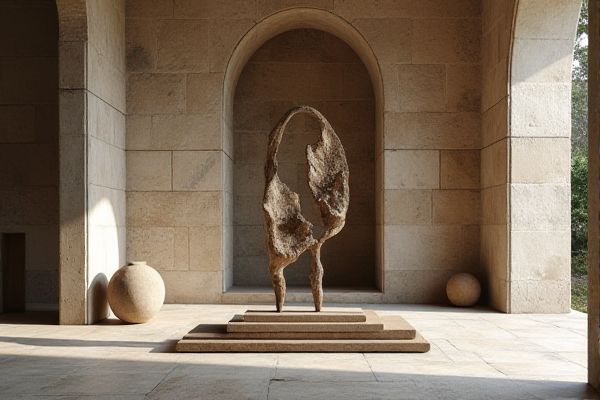
Stone sculpture offers a timeless, natural texture with durability suited for outdoor display, while metal sculpture provides versatility in form and finish, allowing for intricate designs and modern aesthetics. Explore the rest of the article to discover which medium aligns best with your artistic vision and project needs.
Table of Comparison
| Aspect | Stone Sculpture | Metal Sculpture |
|---|---|---|
| Material | Natural stone (marble, granite, limestone) | Metals (bronze, steel, aluminum, iron) |
| Durability | High, resistant to weathering and time | Very high, corrosion-resistant with proper treatment |
| Weight | Heavy | Typically lighter depending on metal and design |
| Workability | Chiseling, carving; labor-intensive | Welding, casting, forging; allows intricate designs |
| Finish | Textured, natural stone appearance | Polished, smooth, or patinated surfaces |
| Cost | Moderate to high, depends on stone type and size | Varies widely; bronze casting is often costly |
| Common Uses | Monuments, statues, architectural elements | Public art, modern sculptures, kinetic art |
| Lifespan | Centuries or more if maintained | Decades to centuries with maintenance |
Introduction to Stone and Metal Sculpture
Stone sculpture involves carving or chiseling materials like marble, granite, or limestone to create durable, textured artworks with a natural finish. Metal sculpture typically uses welding, casting, or forging with metals such as bronze, steel, or aluminum, allowing for intricate details and dynamic forms. Both mediums offer unique artistic expressions, with stone emphasizing solidity and permanence, while metal provides flexibility and strength.
Historical Evolution of Stone vs. Metal Sculptures
Stone sculpture dates back to prehistoric times, with notable examples like the Venus of Willendorf (circa 28,000-25,000 BCE) and ancient Egyptian statues, showcasing enduring durability and ease of carving. Metal sculpture emerged prominently during the Bronze Age (circa 3300-1200 BCE), exemplified by works such as the Riace Bronzes, highlighting advanced metalworking techniques and greater flexibility in form. Over centuries, stone remained favored for monumental and religious art, while metal sculptures gained prominence in decorative and dynamic artistic expressions due to their malleability and strength.
Material Properties: Stone vs. Metal
Stone sculptures exhibit durability and natural texture, characterized by materials like marble, granite, and limestone that offer hardness and resistance to weathering. Metal sculptures utilize metals such as bronze, iron, and aluminum, which provide tensile strength, malleability, and corrosion resistance when treated properly. The inherent properties of stone create a solid, weighty presence, while metals enable intricate designs and dynamic forms due to their flexibility and weldability.
Techniques Used in Stone and Metal Sculpting
Stone sculpture involves carving, chiseling, and grinding techniques to shape hard materials like marble or granite, requiring precision to remove chips and reveal the form within. Metal sculpture uses methods such as welding, casting, and forging, allowing artists to melt or join metals like bronze, steel, or aluminum to create intricate, durable pieces. Your choice between stone or metal sculpting techniques depends on the desired texture, durability, and detail level in the finished art.
Durability and Longevity Comparison
Stone sculptures, carved from materials such as marble, granite, or limestone, exhibit exceptional durability and resistance to weathering, often lasting thousands of years with minimal deterioration. Metal sculptures, typically composed of bronze, steel, or aluminum, offer high structural strength and versatility but require protective coatings or maintenance to prevent corrosion and rust over time. The longevity of stone sculptures generally surpasses that of metal counterparts, especially in outdoor environments where natural elements accelerate metal oxidation.
Aesthetic Qualities and Artistic Expression
Stone sculpture offers a timeless, tactile quality with its natural textures and subtle color variations, evoking a sense of permanence and organic beauty. Metal sculpture excels in versatility and dynamic forms, enabling artists to create intricate details, reflective surfaces, and abstract shapes that capture light and movement. The contrasting mediums influence artistic expression by shaping the emotional resonance and visual impact, with stone emphasizing solidity and tradition, while metal highlights innovation and fluidity.
Iconic Stone Sculptures Around the World
Iconic stone sculptures such as Michelangelo's David in Florence and the Great Sphinx of Giza in Egypt demonstrate the enduring strength and detailed craftsmanship achievable with stone. Unlike metal sculptures, which allow for fluid and intricate designs through casting and welding, stone sculptures emphasize permanence and monumental scale due to the material's heaviness and durability. Worldwide, stone sculpture remains a powerful medium for historical and cultural expression, showcased in ancient works like the Moai statues of Easter Island and contemporary creations like Auguste Rodin's The Thinker.
Renowned Metal Sculptures and Artists
Renowned metal sculptures such as Constantin Brancusi's "Bird in Space" and Alexander Calder's kinetic mobiles showcase the medium's versatility and dynamic form. Artists like Richard Serra have pushed the boundaries of metal sculpture with massive steel installations that engage spatial perception, while Louise Bourgeois incorporated both metal and organic shapes to evoke emotional depth. Your appreciation of sculpture can be enriched by exploring these iconic metal artworks that contrast sharply with the permanence and texture-focused qualities of stone sculptures.
Maintenance and Preservation Challenges
Stone sculpture requires careful protection from weathering, erosion, and pollutants that can cause surface deterioration or discoloration over time. Metal sculpture faces challenges such as rust, corrosion, and oxidation, especially in outdoor environments, necessitating regular cleaning and protective coatings to preserve its integrity. Your approach to maintenance should consider the specific vulnerabilities of each material to ensure long-term preservation of the artwork's appearance and structural stability.
Choosing Between Stone and Metal for Modern Sculpture
Choosing between stone and metal for modern sculpture depends on factors such as durability, texture, and artistic expression. Stone offers a timeless, solid feel with natural variations that enhance organic forms, while metal provides versatility with sleek finishes and the ability to create intricate, dynamic shapes. Your choice should reflect the sculpture's intended environment, whether you prefer the earthy permanence of stone or the contemporary flexibility of metal.
 homyna.com
homyna.com